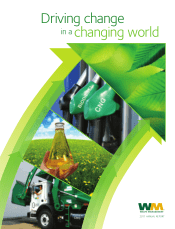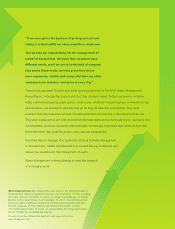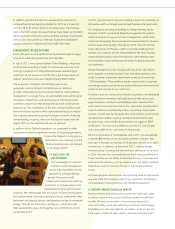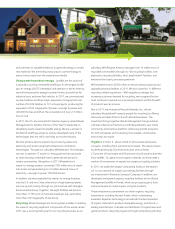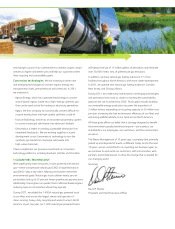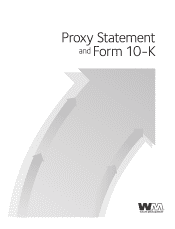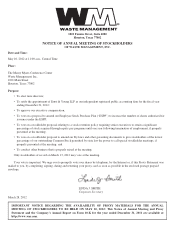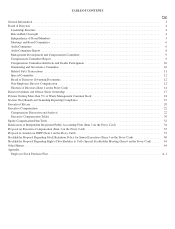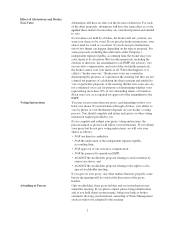Waste Management 2011 Annual Report Download - page 6
Download and view the complete annual report
Please find page 6 of the 2011 Waste Management annual report below. You can navigate through the pages in the report by either clicking on the pages listed below, or by using the keyword search tool below to find specific information within the annual report.
technologies is part of our commitment to redirect organic waste
streams to higher and better uses and help our customers meet
their recycling and sustainability goals.
Conversion technologies. We are investing in other new
and emerging technologies to convert organic energy into
transportation fuels, petrochemicalsand chemicals. In 2011,
we invested in:
8^e`fe<e\i^p#n_`Z__XjXgXk\ek\[k\Z_efcf^pkfZfem\ik
wood-based organic waste into a high-energy synthetic gas
that can be used as fuel for heating or electricity generation
8^`cpo#k_\ÓijkZfdgXepkf\Zfefd`ZXccpZfem\ik[`ũZlck$kf$
recycle waste plastic into high-quality synthetic crude oil
=lcZild9`f<e\i^p#n_`Z__XjXe`eefmXk`m\gifgi`\kXipjpjk\d
to convert municipal solid waste into advanced biofuels
>\efdXk`ZX#Xc\X[\i`eZi\Xk`e^jljkX`eXYc\Z_\d`ZXcj]ifd
i\e\nXYc\]\\[jkfZbj%N\Xi\nfib`e^kf^\k_\i`eXaf`ek
development to use Genomatica’s technology to turn the
synthetic gas made from municipal solid waste into
high-value chemicals.
These complement our previous investments in conversion
technology platforms, including Enerkem, InEnTec and Terrabon.
CLEAN FUEL TECHNOLOGY
With significantly lower emissions, trucks powered with natural
gas—either compressed natural gas (CNG) or liquefied natural
gas (LNG)—play a key role in helping communities meet their
environmental goals. Natural gas trucks deliver nearly zero air
gXik`ZlcXk\jXe[lgkf),g\iZ\ek]\n\i^i\\e_flj\^Xj\d`jj`fej%
Additionally, the engines run quieter than traditional diesel engines,
reducing noise in communities where they operate.
;li`e^)'((#n\X[[\[k_\(#+''k_eXkliXc^Xjgfn\i\[kilZb
to our fleet, and we are the largest owner and operator of
clean-running, heavy-duty recycling and waste trucks in North
8d\i`ZX%@ealjkfe\p\Xi#fli(#+''eXkliXc^Xjgfn\i\[kilZbj
will replace the use of 11 million gallons of petroleum and eliminate
fm\i*'#'''d\ki`Zkfejf]^i\\e_flj\^Xj\d`jj`fej%
@eX[[`k`fe#n\_Xm\eXkliXc^Xj]l\c`e^jkXk`fejXk(.f]fli
facilities throughout North America, with more underdevelopment.
In 2011, we opened new natural gas fueling stations in Camden,
New Jersey, and Chicago, Illinois.
During 2011, we made many investments in emerging technologies
and operations that move us closer to reaching the sustainability
goals we set out to achieve by 2020. Those goals include doubling
our renewable energy production to power the equivalent of
2 million homes, expanding our recycling capacity to 20 million tons
per year, increasing the fuel and emission efficiency of our fleet, and
enhancing wildlife habitats on our lands across North America.
All these goals affirm our belief that a strategy designed to benefit
the environment greatly benefits everyone—our business, our
shareholders, our employees,our customers, and the communities
we serve.
The Waste Management of 10 years ago, a company that primarily
picked up and disposed of waste, is different today. And in the next
10 years, we are committed to re-inventing our business again, as
we continue to work with our customers, with communities, with
partners and entrepreneurs, to drive the change that is needed for
our changing world.
Sincerely,
David P. Steiner
President and Chief Executive Officer

